When it comes to blending ornamental elegance with hardiness, few shrubs rival the Lawrence Oleander (Nerium oleander ‘Lawrence’).
This stunning plant, adored for its lavender-pink blooms and lush evergreen foliage, is not just a decorative choice but also a practical one.
Popular in Mediterranean-style landscapes, coastal gardens, and drought-prone regions, the Lawrence Oleander continues to be one of the most versatile plants in modern horticulture.
But beyond its undeniable beauty lies a list of benefits that make this plant a true gem for gardeners and landscapers alike.
In this guide, we’ll take a closer look at its charm, practical uses, growing requirements, and why it might just be the perfect addition to your outdoor space.
🌿 1. A Timeless Symbol of Beauty
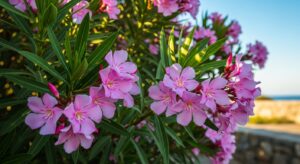
The Lawrence Oleander is best known for its clusters of pastel blooms, typically in lilac, lavender, or pale pink.
These flowers contrast beautifully with their deep green, leathery leaves, creating a lush and eye-catching display.
Unlike many other flowering plants, oleanders bloom for long stretches of the year, often from late spring through early autumn, ensuring your garden is never short of color.
Its romantic appeal makes it a favorite in both traditional gardens and modern minimalist landscapes.
Historically, oleanders have been cultivated for centuries in Mediterranean and Asian gardens, often symbolizing endurance, resilience, and everlasting beauty.
🌞 2. Resilience in Harsh Conditions
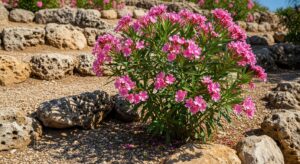
One of the most remarkable features of Lawrence Oleander is its ability to thrive in tough conditions. This shrub is:
-
Heat-tolerant 🌞 – It thrives under direct sun without fading.
-
Drought-tolerant 💧 – Once established, it needs very little water, making it ideal for arid regions.
-
Soil-adaptable 🌱 – From sandy coastal soil to poor rocky terrain, it grows well almost anywhere.
For gardeners living in climates where water conservation is key, oleander is a smart, eco-conscious choice.
🏡 3. Privacy, Windbreaks, and Noise Control
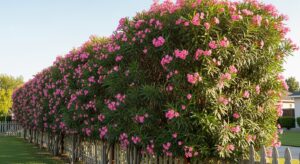
If you’ve ever wished for a natural fence that doubles as a floral display, Lawrence Oleander is your answer. Growing between 6–10 feet tall (sometimes more with care), it forms a dense hedge that offers privacy from neighbors while softening outside noise.
When planted strategically, it can also act as a windbreak, shielding more delicate plants in your garden and creating a more comfortable microclimate for your outdoor space.
🦋 4. A Haven for Pollinators
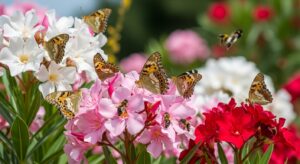
Pollinators love oleander blossoms. The sweet clusters attract bees, butterflies, and even hummingbirds, turning your garden into a small biodiversity hub.
By planting Lawrence Oleander, you’re contributing to supporting pollinator populations, which are essential for healthy ecosystems.
Even if the oleander itself is not edible, its ability to attract pollinators helps boost the productivity of nearby fruit trees and vegetable beds.
🌍 5. Eco-Friendly and Water-Wise Gardening

Water scarcity is an increasing concern for many gardeners, especially in warmer regions. Lawrence Oleander offers a sustainable alternative to thirsty ornamental plants.
By requiring minimal watering once established, it significantly reduces outdoor water use.
This makes it an excellent candidate for:
-
Xeriscaping (landscaping that reduces or eliminates irrigation).
-
Coastal landscaping, where plants must tolerate sandy soils and salt spray.
-
Low-maintenance gardens, where resilience is as important as beauty.
✂️ 6. Landscape Versatility

One of the reasons Lawrence Oleander remains so popular is its flexibility in design. Depending on how you plant and prune it, it can serve multiple roles:
-
🌸 Flowering Hedge – Thick, lush, and colorful, perfect for borders.
-
🌿 Shrub Backdrop – A dark green background that allows smaller flowers to shine.
-
🪴 Container Plant – Suitable for patios, courtyards, and balconies.
-
🌺 Garden Focal Point – A standalone ornamental shrub that draws attention.
It works equally well in formal gardens (with neat pruning) and wild gardens (when allowed to grow freely).
🛠️ 7. Low Maintenance and Easy Care
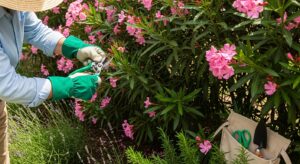
If you’re someone who loves beautiful plants but doesn’t have much time for intensive gardening, Lawrence Oleander is a great match. Caring for it involves:
-
Minimal pruning (to shape hedges or remove dead stems).
-
Occasional deep watering during extreme droughts.
-
Basic feeding with a balanced fertilizer in early spring.
Its disease resistance also makes it a hardy choice, though gardeners should watch out for common pests like aphids or scale insects.
⚠️ 8. A Note of Caution: Toxicity
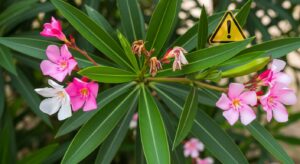
While Lawrence Oleander is admired for its beauty, it does come with a warning: all parts of the plant are toxic if ingested.
This includes the leaves, flowers, stems, and even the smoke from burning its wood.
For households with pets or young children, it’s important to plant oleander in areas that are less accessible or to opt for container arrangements out of reach.
Gardeners should also wear gloves when pruning to avoid skin irritation.
Despite this, many people continue to plant oleander responsibly, as its benefits often outweigh the risks with proper care and awareness.
🌸 Conclusion
The Lawrence Oleander is a rare combination of beauty, strength, and practicality. With its long-lasting blooms, low water needs, and ability to serve as both a decorative and functional plant, it continues to be a landscaper’s favorite around the world.
From creating private, serene retreats in suburban backyards to bringing bursts of color to coastal gardens, this resilient shrub adds value wherever it’s planted.
If you’re looking for a plant that offers enduring beauty with minimal effort, the Lawrence Oleander may just be the perfect addition to your garden.
❓ 10 FAQs on Lawrence Oleander
1. What is Lawrence Oleander?
Lawrence Oleander (Nerium oleander ‘Lawrence’) is an ornamental shrub known for its pastel lavender-pink flowers and evergreen foliage.
2. How tall does Lawrence Oleander grow?
It typically grows 6–10 feet tall but can reach 15 feet if left unpruned.
3. Is Lawrence Oleander drought-tolerant?
Yes, once established, it thrives with minimal water, making it ideal for xeriscaping.
4. Can Lawrence Oleander grow in poor soil?
Absolutely—it adapts well to sandy, rocky, and nutrient-poor soils.
5. Is Lawrence Oleander safe for pets and children?
No, all parts of the plant are toxic if ingested. Extra caution is needed in households with pets or children.
6. Does Lawrence Oleander attract wildlife?
Yes, its blossoms attract bees, butterflies, and hummingbirds.
7. How often should I prune Lawrence Oleander?
Pruning once or twice a year is enough to maintain shape and remove dead growth.
8. Can Lawrence Oleander be grown in containers?
Yes, smaller varieties thrive in large pots, making them perfect for patios and courtyards.
9. What climates are best for Lawrence Oleander?
It thrives in warm, sunny climates (USDA zones 8–11) and is particularly suited for Mediterranean and coastal regions.
10. How long does Lawrence Oleander bloom?
It blooms from late spring to early autumn, with flowers lasting months.